6.01.2022
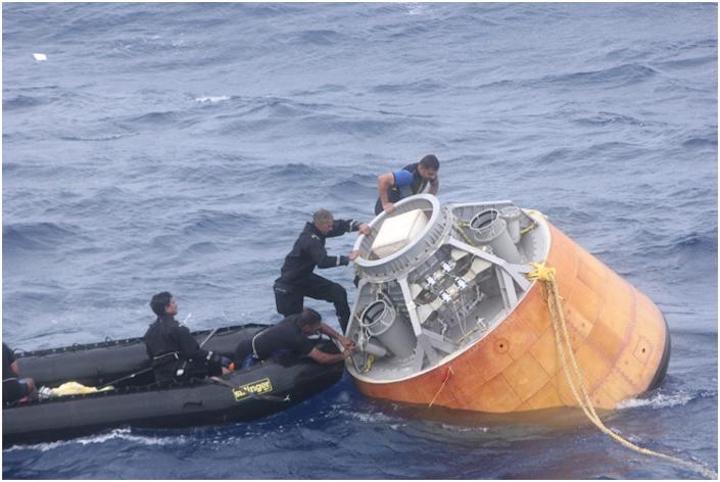
As the Indian Space Research Organisation (ISRO) is going at full throttle for Gaganyaan, the country's maiden manned space mission scheduled for launch in 2023, interesting details of the Crew Module (CM), including the landing choices, Crew Escape system, and survival packets for each crew member, have emerged.
The CM would be splashing down near the Indian coast in 2023 after the week-long mission, and the Arabian Sea, which is comparatively calmer, is the primary choice, but Bay of Bengal is also being considered as a backup option, writes Unnikrishnan Nair S, Director, Human Space Flight Centre (HSFC), ISRO, Bengaluru, in an article titled ‘Indian Human Space Mission’.
The HSFC was set up by the ISRO in Bengaluru in 2019 for sustained and affordable human space flight activities and Gaganyaan is the first project.The test flight to validate the performance of Crew Escape System and the first uncrewed mission of Gaganyaan have been scheduled at the beginning of the second half of 2022.
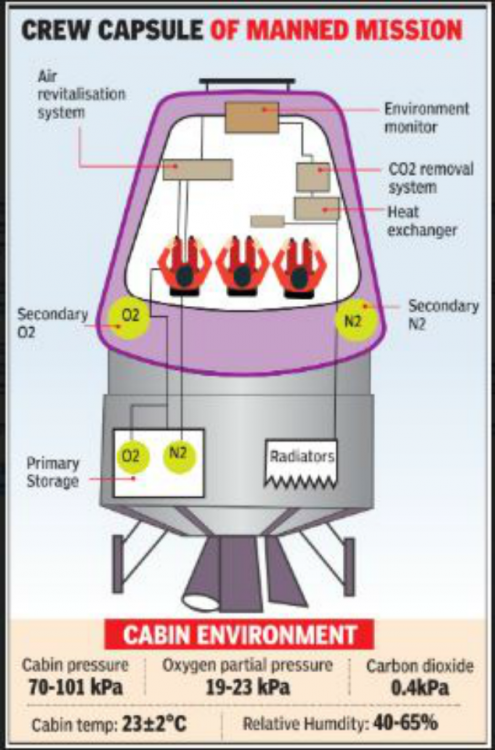
The Gaganyaan Orbital Module (OM) has two parts — the Crew module (CM) and the Service module (SM) — and weighs about 8,000 kg. While in orbit, the OM will be orbiting the Earth with a velocity of about 7,800 m/s. The CM, a double walled system and the habitat of astronauts, who would be part of the manned mission, has an ablative Thermal Protection System (TPS) to protect it during the intense aerodynamic heating during the flight, points out Nair.
He said the Orbital module will be launched by Human Rated Launch Vehicle (HRLV), which is a modified version of GSLV MK-III vehicle. The CM has a cluster of small thrusters with 100N thrust level based on green propulsion that will be fired in controlled manner to change the attitude of the module during the re-entry and atmospheric phases of flight.
After landing, the coordinates of CM will be passed on to the recovery team waiting in ships. The CM has survival packet for each crew that can support them for nearly two days. However, ISRO is positive that the crew can be recovered within two hours after the splash down.
For Gaganyaan, the selected four astronaut candidates have undergone generic space flight training at Russia for nearly 15 months. The Gaganyaan-specific training will be carried out in India at the Astronaut Training Facility being set up at Bengaluru.
The crew will be familiarised with all conceivable situations that can happen while in flight and they will be trained to face such situation. The training will include classroom sessions on different engineering, medical and safety aspects of the mission. The crew will undergo training in weightlessness condition by flying in special aircraft through a parabolic path that will give 25 to 30 seconds duration of weightlessness.
In order to familiarise the crew with rescue under abort conditions, they will undergo special survival training in sea, snow, mountain and desert conditions. They will be taught to survive in such situation making use of the survival kit available with them. The crew will also undergo long duration training in special simulators that will mimic the interior of crew module.
Quelle: The Hindu
+++
Where will Gaganyaan mission land? Isro to choose between Arabian Sea and Bay of Bengal
The crew, which consists of four Indian Air Force (IAF) officers, whose identities remain confidential, have completed the foreign leg of their training.
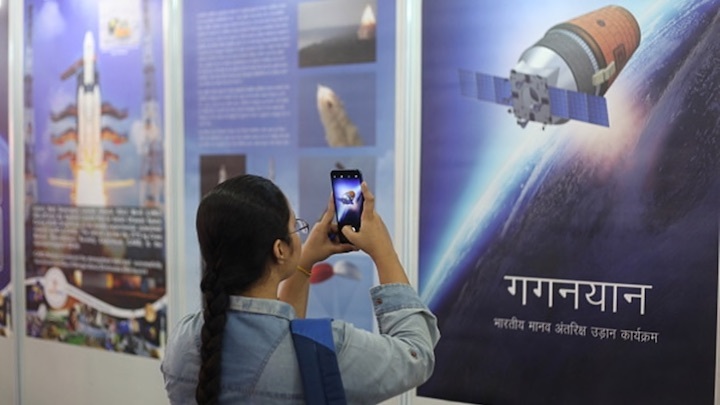
The Gaganyaan mission, set to launch with three Indian astronauts as soon as 2023, will splash down near the Indian coast. New details have emerged about the choices of the landing zone, which could be either in the Arabian Sea or the Bay of Bengal.
Dr Unnikrishnan Nair, Director, Human Space Flight Centre (HSFC), Isro in an article in Manorama Yearbook 2022 has written about the progress of the mission, which could have its first uncrewed flight by the end of this year. The Human Space Flight Centre is working on validating the performance of the Crew Escape System that will be part of the module.
The Gaganyaan Orbital Module (OM) has two parts the Crew module (CM) and the Service module (SM) and weighs about 8,000 kg. While in orbit, the OM will be orbiting the Earth with a velocity of about 7,800 m/s. The Orbital module will be launched by a Human Rated Launch Vehicle (HRLV), which is a modified version of GSLV MK-III launch vehicle.
The Command Module (CM), a double-walled system and the habitat of astronauts, has an ablative Thermal Protection System (TPS) to protect it from the intense aerodynamic heating during the flight, points out Dr Nair. The report further stated that the Command Module, equipped with a survival packet for each crew that can support them for nearly two days, will be rescued by the recovery team upon landing in either of the two sites.
The crew, which consists of four Indian Air Force (IAF) officers, whose identities remain confidential, have completed the foreign leg of their training and the Indian leg has commenced. During their training in Russia, they underwent generic space flight training and the Indian leg will see them getting familiar with all conceivable situations that can happen while in flight.
The crew will undergo training in weightlessness conditions by flying in special aircraft along a parabolic path that will give 25 to 30 seconds duration of weightlessness.
In order to familiarise the crew with rescue under abort conditions, they will undergo special survival training in sea, snow, mountain and desert conditions. They will be taught to survive in such situations making use of the survival kit available with them. The crew will undergo training in weightlessness conditions by flying in special aircraft through a parabolic path that will give 25 to 30 seconds duration of weightlessness.
In order to familiarise the crew with rescue under abort conditions, they will undergo special survival training in sea, snow, mountain and desert conditions. They will be taught to survive in such situations making use of the survival kit available with them. The crew will also undergo long duration training in special simulators that will mimic the interior of the crew module.
The new details come days after Isro chairman K Sivan in his new year message said that they are hopeful of launching the first unmanned mission this year. "Tests are in progress for the human-rated L110 Vikas engine, Cryogenic stage, Crew escape system motors and service module propulsion system. The S200 motor has been realised for the ground test too. Main parachute drop test has also commenced," Sivan said.
Quelle: INDIA TODAY
----
Update: 11.01.2022
.
Gaganyaan crew will have 2 landing choices: Isro expert

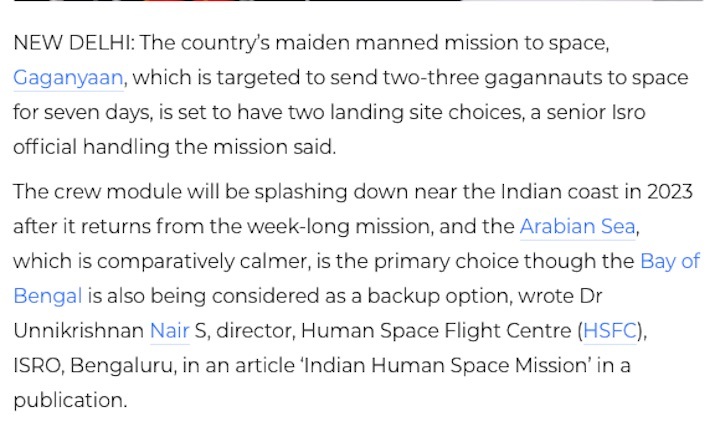
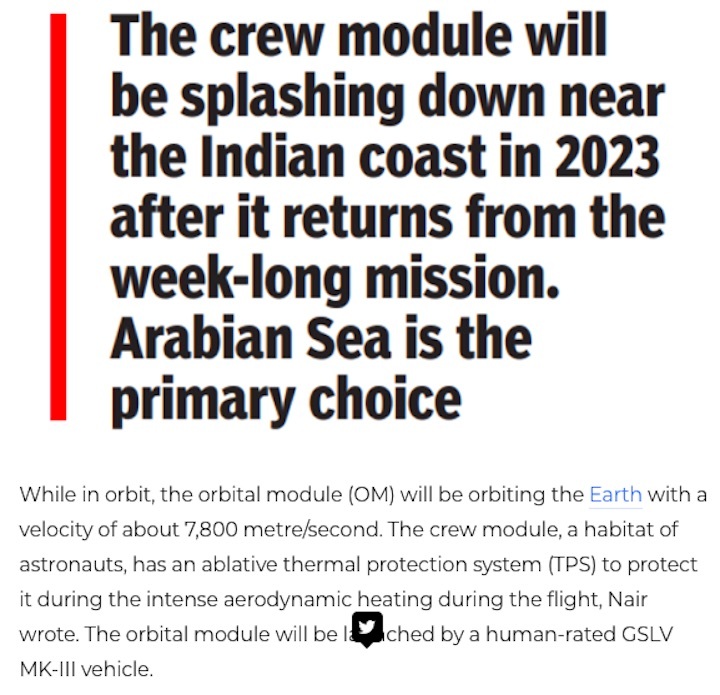
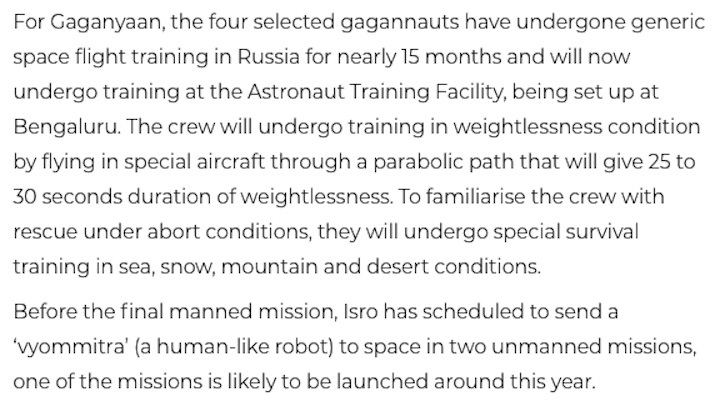
Quelle: THE TIMES OF INDIA
